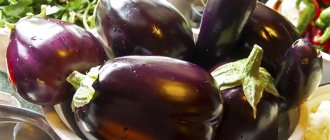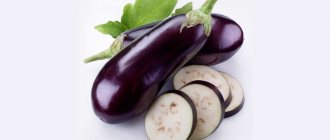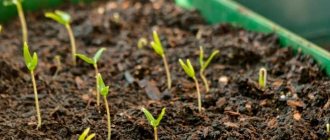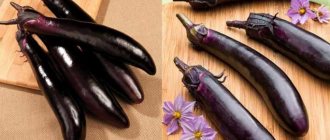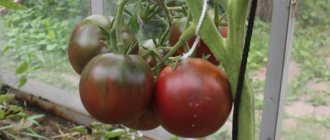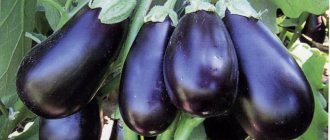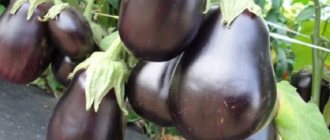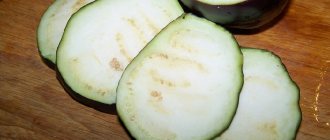- Tips for growing seedlings
The high-yielding eggplant “Black Beauty” is a real decoration of the garden - its fruits have a spectacular appearance thanks to their almost black glossy surface and heart-shaped shape. The variety also has other valuable features: excellent taste of vegetables, universal purpose, high marketability, good transportability.
“Black Beauty” is intended for gardening in open ground
The main characteristics of the variety are presented in the table:
| Parameter | Characteristic |
| Culture | Eggplant (Solanum melongena L.) |
| Variety | "Black Beauty" |
| Ripening time | Medium: the period from emergence to technical ripeness of the fruit lasts 115-120 days |
| Productivity | 3.5-4 (up to 10) kg/m2 with industrial cultivation 336 c/ha |
| Fruit weight | 112-200 g (according to the originator 200-250 g) |
| Appearance of the fruit upon reaching technical ripeness | Pear-shaped or heart-shaped, surface glossy, brownish-violet |
| Taste qualities | Excellent, no bitterness |
| Year of registration in the State Register of the Russian Federation | 2006 |
| Recommended growing regions | Central Black Earth, North Caucasian |
| Originator | Agrofirma Poisk LLC (Moscow region) |
From the history of the creation of the variety
Black beauty is a relatively young variety. In its description in various sources, there are inaccuracies in the characteristics of the properties of eggplant and the history of its creation. In fact, everything is elementary.
Interesting!
In English, Black Beauty sounds like Black Beauty (black - black; beauty - beauty). This is the name of a Dutch variety of eggplant that has existed for a long time. It is this fact that has caused some confusion.
The black beauty was created by breeders of the Poisk agricultural company from the Moscow region. In addition, the vegetable was positioned for growing on small plots or farms. The variety was included in the State Register of the Russian Federation in 2006. Eggplant was recommended for cultivation in open ground. But in central Russia and the northern regions there are not enough warm days for the vegetable to ripen. Under a film cover or in a greenhouse, even in cool climates, eggplant pleases gardeners with abundant harvests.
Features of care
The basic rules for caring for eggplants of the Black Beauty variety are practically no different from the general rules of agricultural technology for the mentioned vegetable crop.
However, it is necessary to take into account some features of the variety:
- When seedlings are placed in open ground, it is recommended to cover them with film at night for one or two weeks, since a sharp drop in temperature is detrimental to immature seedlings. The crop is extremely demanding of light, so covering material is not used during the daytime.
- After replanting, it is advisable not to water the plants for a couple of weeks, but to carefully spray them, occasionally adding urea to the water.
- After the seedlings have grown stronger, watering is carried out regularly, at the root, with water at a temperature of +25°C, avoiding waterlogging of the soil. Cold water slows down plant growth. After the fruit is formed, you can water the bushes from above (with a hand watering can).
- Black beauty is a tall plant, so it is necessary to pinch the top of the bush when the height of the stem reaches about 20 cm (maximum - 35 cm). Leaves and lateral shoots must be removed before the first branch. This is necessary for the formation of a powerful plant and full-fledged fruits.
It will also be useful for you to know why and what to do if the eggplants dry out and if the leaves of the eggplants wither.
Vegetable crops are fertilized three times a season with mineral and organic (a solution of manure or bird droppings) fertilizers:
- the first - 10 days after transplanting the seedlings into open ground;
- the second - another 10 days after the first feeding;
- the third - at the beginning of active fruiting.
Weeding and hilling on a regular basis are necessary for the formation of developed adventitious roots.
Characteristics and description of the variety
Breeders position Black Beauty as a mid-season variety, that is, gardeners harvest no earlier than 4 months after planting.
The vegetable is not a hybrid. Black beauty is a varietal eggplant. Accordingly, there is no need to buy seeds annually. You can stock them yourself.
The plant is a bush, quite compact, growing up to 75-80 cm in height.
- The stems are strong, strong, covered with short fluff, and can bear a large number of fruits without breaking. Eggplants ripen 5-7 pieces on one bush. They are small, up to 20 cm in length. Weighing 230-280 grams.
When grown skillfully, they surprise you with their size (source: 7dach.ru) - Green leaves with jagged edges, the blades of which have thorns.
- The fruits are heart-shaped, glossy purple, almost black (hence the name of the variety). The peel of the fruit is not thick, shiny. Young eggplants can be eaten without peeling. The pulp has a yellowish tint and a pleasant taste. It doesn't taste bitter.
- The variety is productive. From 1 sq. m, gardeners harvest up to 6 kg of eggplants, sometimes up to 10 kg.
In order to obtain a bountiful harvest, gardeners sometimes pollinate flowers by hand or lure pollinating insects to the beds by spraying various sweet baits on the plants. It's not difficult to prepare them:
- 150 g sugar;
- 5 g boric acid;
- 1.5 liters of hot water.
Due to its taste, the variety is universal in use:
- it is preserved and pickled;
- baked and fried;
- preparing caviar.
The black beauty is relatively resistant to diseases. Having planted this variety on their plot, gardeners will not be left without a harvest of delicious and healthy eggplants.
Growing conditions
Initially, the Black Beauty eggplant variety was recommended for growing in unprotected soil in warm climates. In the southern regions: in the Krasnodar Territory, in the Caucasus, eggplants are grown by planting seeds directly into the ground.
Considering that summer in central Russia lasts only 3 months, and not all of them can be warm, it becomes obvious that in such conditions the vegetable will not have time to ripen. For it you need to create a warm climate (greenhouse or film) and plant seedlings.
It is advisable to buy ready-made soil for it in the store, this will protect you from problems with soil preparation.
If you use garden soil for seedlings, you will have to spend a lot of time disinfecting it from fungus, applying fertilizers, etc.
It is also recommended to process the seeds to speed up their growth and enhance viability. For processing, a 1% solution of potassium permanganate is suitable, in which the seeds must be placed for a quarter of an hour. In order to increase viability, the seeds are placed in an ash solution or in a mixture of sodium humate or nitrophoska. Dilute in the following proportion: 10 g of substance per 1 liter of water.
- You should start planting seedlings in February, using small pots. 2-3 seeds are buried in them no more than 2 cm. Then they are moistened with a spray and covered with film. After 2 weeks, the first shoots should appear.
- The dishes with seedlings are placed in a warm and well-lit place. For planting in the ground, the strongest and strongest sprout is left in the greenhouse.
- Young plants need to be watered, loosened (very carefully so as not to damage the roots), and be sure to be fed with organic matter and minerals.
When 7-8 leaves appear on the seedlings, no earlier than after 2 months, the seedlings are transferred to a permanent growing place: a greenhouse or greenhouse.
Before planting young plants, it is necessary to prepare the soil. This is done either in the fall or before planting. Organic fertilizers are added to the soil: either manure or compost; mineral fertilizers, for example, nitrogen (no more than 10 g per 1 sq. m.) will not be superfluous.
Growing Tips
- It is not advisable to plant eggplants next to tomatoes.
- Plant Black Beauty in the ground when warm weather sets in, when the air temperature does not drop below 15 degrees and night frosts do not “threaten” (late May or early June for the middle zone).
- Change the location of planting eggplants annually.
- Before planting seedlings, it is necessary to disinfect the bed, for example, pour boiling water over it in order to destroy bacteria that cause plant diseases.
A hole is made for each seedling; the distance between them should be at least half a meter.
Eggplants get sick when transplanted, so it is better not to disturb them for 2-3 days (do not loosen or water them) until they take root in the new place.
Harvesting and application
Fruit harvesting begins 30–40 days after flowering . Vegetables do not all ripen at once, so they are picked selectively, checking technical ripeness. It is determined by its appearance: the skin becomes dark in color, the flesh becomes elastic.
The culture is not suitable for long-term storage: the freshness and taste of the fruits remain for up to 2–4 weeks when the vegetables are in the refrigerator or basement.
Eggplants are widely used in cooking. Young fruits are suitable for main courses, larger ones - for homemade preparations, sautés, caviar and other snacks. Overgrown eggplants can be frozen or dried.
Caring for Black Beauty
This variety of eggplant does not require any special cultivation measures. Therefore, plant care is standard:
- feeding;
- loosening the soil;
- watering.
Loosen the soil to provide air access to the roots and prevent them from rotting.
It is necessary to water frequently to prevent the soil from drying out. Moreover, watering is done with warm water, which has had time to warm up in the sun.
- The first feeding: potassium-phosphorus is carried out 20 days after planting in the greenhouse. For this purpose, you can buy ready-made mineral fertilizer, including: phosphorus, nitrogen and potassium.
- The eggplants are fed a second time when the plant begins to bud (1 matchbox of saltpeter is diluted in 10 liters of water). Water the solution at the root of the plant.
- The third feeding is nitrogen-phosphorus, carried out as soon as the first fruits are formed (2 tablespoons of ammophosphate are diluted in 10 liters of water).
- 20 days before harvest, it would not hurt to add a potassium and superphosphate mixture (1.5 tbsp of each component per 10 liters of water).
Proper care of the plant will delight you with a bountiful harvest of tasty and healthy eggplants.
Landing
Seed material is soaked in warm water (temperature 40-45 degrees). For stimulation, you can use folk remedies or ready-made solutions (Epin, Albit, Kornevin).
The seeds are sown in a peat-humus mixture, the spacing between seedlings is maintained at 3 cm, and the seeding depth is within 1.8 cm.
Boxes and cups with seedlings are kept under film until the first seedlings hatch.
The seedlings are watered with water at a temperature of 30-36 degrees. Young bushes dive when they grow 2 leaves. Fertilizers for preparing nutrient solutions for seedlings:
- Fertika Lux;
- Bud;
- Epin Extra.
Diseases and their prevention
Despite the relative resistance of the Black Beauty to diseases, it is still better to prevent the most common ones.
- Black leg and gray rot often affect eggplants. To prevent them, it is advisable to purchase special preparations and fungicides (there is a large selection in stores). In this case, the diseased areas are destroyed.
- Late blight. Treating the plant with Bordeaux mixture will help. Wood ash, which must be sprinkled on the ground around the bush, will not hurt.
- For mosaic, spray with phytosporin or other drugs.
The Colorado potato beetle loves eggplants. It is difficult to fight with it; the old proven method helps - collecting the beetle by hand.
Insecticides will help against aphids, spider mites and whiteflies.
Valuable and weak qualities of the variety
Thorns
To summarize what has been said about the Black Beauty eggplant variety, it is worth noting its positive and negative sides.
| Advantages of the variety | Flaws |
| Eggplant is not a hybrid. | There are thorns (pricks when harvesting). |
| Gives generous harvests. | It does not tolerate temperature changes well and does not like waterlogging of the soil, as a result of which the ovaries and flowers may fall off. |
| The fruits are tasty, without bitterness, few seeds. | |
| Eggplants are versatile in their use. | |
| They are well transported because the peel is dense and not fragile. Retains its presentation for a long time. |
Thus, the Black Beauty eggplant variety, under proper growing and care conditions, guarantees a high yield of excellent vegetables.
Fruit storage
Eggplant fruits collected unripe are best stored in the refrigerator. If the harvested crop is immediately placed in a cool, dark room, the eggplants can be stored for about a month without loss of taste.
Black beauty has decent taste and produces consistently high yields. The plant does not require care and has good resistance to diseases and pests. It is these qualities that make the variety popular among gardeners.
You can find more information about different ways to store eggplants here.

